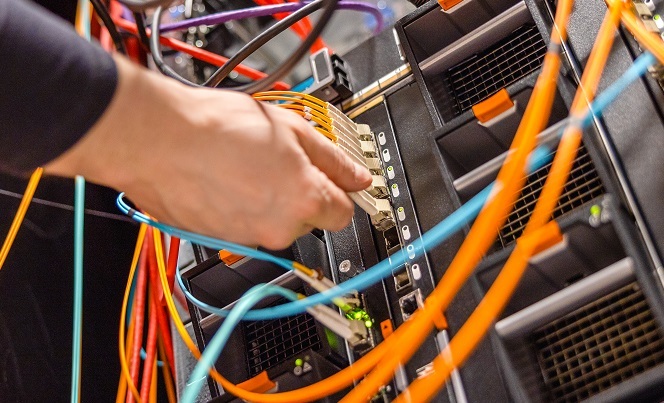
 Data Structure
Data Structure Networking
Networking RDBMS
RDBMS Operating System
Operating System Java
Java MS Excel
MS Excel iOS
iOS HTML
HTML CSS
CSS Android
Android Python
Python C Programming
C Programming C++
C++ C#
C# MongoDB
MongoDB MySQL
MySQL Javascript
Javascript PHP
PHP
- Selected Reading
- UPSC IAS Exams Notes
- Developer's Best Practices
- Questions and Answers
- Effective Resume Writing
- HR Interview Questions
- Computer Glossary
- Who is Who
What is the full form of FCP?
Introduction
Fiber Channel Protocol (FCP) is a protocol is a set of instructions or rules given by a computer". Fiber Channel(FC) is a method of carrying information over fibre optic or copper fibre at high speed and low reluctance.

FCP is also known as FC i.e. "Fiber channel". It works on SAN, DAS and NAS topology. It uses up to 128 GBPS speed for data transfer for a distance of 10 Km.
Its development started in 1988 as IPI (Intelligent Peripheral Interface) and the draft was completed in 1989. Later ANSI approved FCP in 1994.
Definition of FCP
"Fiber Channel Protocol" is a small Computer System Interface(SCSI) that is used to build a fibre channel network. It provides rapid data transfer utility to link mainframes, servers, workspaces, and supercomputers.
The prime work of FCP is to transfer bulk data at high speed so that it can be transferred to other channels.
It works on copper or optical fibre.
It is capable of transferring data up to "128 Gbps" hence also known as GFC i.e. "Gigabit Fibre Channel".
It works on three topologies Storage Area Network(SAN), Direct Attached Storage (DAS), and Network Attached Storage (NAS).
Features of FCP
"Fibre channel" frames have five layers of communication that are distinct from the "open system Interconnection (OSI) Model". It works on frames for rapid transmission between nodes.
First is the physical Layer (FC-0)
The second is the transmission layer (FC-1)
Third is the Signalling layer or Framing Layer (FC-2)
Fourth is Common Service Layer (FC-3)
Fifth Upper layer Protocol Mapping (FC-4)
These layers are framed upside down means that FC-0 is placed at the lowest and FC-4 is placed at the top of the frame.
An important feature of FCP frames is that new technology can be inserted at any layer without disrupting the design of the layer.
There are four Fiber channel components these component are; Switches, Hot Bus Adapters (HBAs), Ports and software.
Switches It defines the origin and destination of data transmission with high ability and low latency.
HBAs It connects the server and network devices. It works akin to an Ethernet adapter.
Ports Data is sent and received through these ports.
Software It allows the visualization, control and management of fibre channels.
Fibre channel addressing is based on worldwide names(WWN).
Applications of FCP
Fiber Channel Protocols are used for transferring high-speed data among servers, workstations, mainframes and supercomputers without discontinuation and delay.

It is used in "Storage Area Networks"(SAN) in commercial spaces.
FCP can transmit large amounts of data at high speed.
It is used in high data transfer techniques like video editing, scientific research, high efficient computing.
Financial institution stores private data like customer information through FCP so safety and integrity and ensures the transfer of the information without any loss of data.
Multimedia companies use fibre channels
It is used in storage area networks where corrupt-free and analytical data is required.
Advantages of FCP
There are various benefits of the "Fibre Channel protocol".
FCP use multiple topologies that comprise point-to-point configuration, loops and switches that ensure flexible and valuable protocol and are used in networking.
It allows high-quality and reliable error-free data transfer without any loss of information.
It can transfer large amounts of video data and reduce editing and post-production.
It has good bandwidth, flow control and speed, and can transfer data up to 10 km.
It is more balanced and more reliable than SCSI.
Conclusion
"Fiber Channel Protocol" (FCP) is a technology used for rapid data transfer among workstations, computers, supercomputers and mainframes. Its capability of data storage rate is around "128 Gbps". It was developed by "The American National standard institute" accredited committee "International Committee for Information Technology Standards". Earlier it was used in supercomputers but now is used in "Storage Area Networks" (SAN), and IP networks of Transport protocol. It is used commonly in upper layer protocol of ATM, IP networks, etc.
FAQs
Q1. What are the disadvantages of the Fibre Channel protocol?
Ans: Although the fibre channel protocol is efficient and reliable it has a few disadvantages too. "Fibre channels" are quite expensive. It needs cards in the server and switches and fibre cables. Fibre cables are thin than metallic wire, so there is the possibility of being damaged. It spreads light in one direction only.
Q2. What type of connections are made by the Fibre channel?
Ans: The "fibre channel" forms various connections; between Host to host, server to server, at efficient workstations, between LAN and printer, Multimedia transfer, in parallel processing, etc.
Q3. What are the advantages and disadvantages of Fiber Channel over Fiber Channel over Ethernet?
Ans: "Fibre channels" can transfer data up to 10 Gbps which is higher than Ethernet. In FCoE, the traffic is sent on the same network. Although FCoE is more cost-effective than FC. You don't need to buy costly hardware for FCoE.

